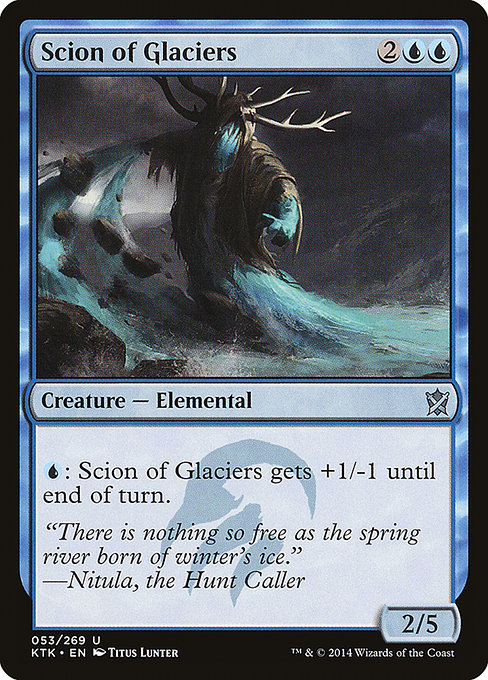
Image courtesy of Scryfall.com
Artist Commentary and Production Techniques in MTG Card Design
Blue magic meets Temur temperament in this Khans of Tarkir standout, a creature whose serenity masks precise engineering. The painterly handling of ice and water, the way the model reads as both a guardian and a hinge point for tempo, all speak to a larger conversation about how an evocative image is built—from concept to ink to the high-res scan that makes it into a card archive. 🧙♂️🔥 As fans, we don’t just admire the final product; we hear the brushstrokes behind it, and Titus Lunter’s work on this piece gives us a taste of careful planning and bold experiments that define modern card art. 🎨
From concept to canvas: the art behind the card
The creature you see is a blue Elemental, a design choice that underscores the frosty, river-born motif embedded in its flavor. The Temur watermark situates it within a clan that thrives on clash and contrast—cold ice meeting volatile energy—an aesthetic that Lunter translates with a cool palette of ultramarine blues, icy whites, and subtle teals. The concept likely started with a language of motion: wind-swept ice shards fused with a resilient silhouette, suggesting a being that embodies both the fragility and the force of winter rivers. 🧊 The final composition balances a strong, broad profile with delicate details—each glint of light on crystal, each ripple of water, carefully lit to guide the eye toward the creature’s core strength: resilience. 💎
In the production room, the process often unfolds in stages you can only glimpse in the final image. Initial sketches establish the pose and energy, then digital painting layers build texture, depth, and atmosphere. A high-res scan or digital capture preserves micro-textures—the frost edge on the creature’s shoulders, the faint spray where water meets air, and the way light bleeds through translucent surfaces. Color grading shifts the balance toward cool tones, while highlight work creates the illusion of a cold breath in the air. The result is a single frame that feels both ancient and newly minted for a set that celebrates the clash of elements. 🎲
“There is nothing so free as the spring river born of winter's ice.” —Nitula, the Hunt Caller
Design notes that matter to players and collectors
- Mana cost and color identity: {2}{U}{U} marks Scion of Glaciers as a blue creature with a singular, economical mana investment. The ability represented in-game—{U}: This creature gets +1/-1 until end of turn—offers tempo-based wrinkles, letting you poke at the opponent during their turn while keeping the board presence steady. This is a classic blue trick: small optimizations that stack over time.
- Stats and survivability: With a 2/5 body, this Elemental leans into defense, presenting a sturdy roadblock in the midgame. It’s not going to smash in for big blows, but it earns its keep by weathering early pressure and enabling late-game plans that hinge on careful mana sequencing and spell manipulation. ⚔️
- Design era and frame: Released in Khans of Tarkir’s 2014 window, it sits in the 2015-era frame that modernized the look while preserving classic card-carved lines. The black border and clean typography frame its icy aura, and the art’s sharp focus contrasts with the slightly hazy, action-poised background—an intentional pull toward clarity amid chaos. 🎨
- Flavor and lore: The flavor text echoes a river’s freedom born from winter, a line that ties into Tarkir’s elemental storytelling while giving the artwork a mythic echo. Flavor is the seasoning that makes the image linger long after you read the card’s rules. 💎
- Rarity and value: An uncommon with foil and nonfoil options, this card quietly populates many players’ collections. Its value isn’t in flashy competitive edge, but in the craftsmanship of the artwork and the storytelling embedded in the image. A well-loved piece for players who enjoy both function and story. 🎲
When you study the card in the context of a broader deck, you’ll notice how the blue tempo engine can interact with other elements—bounce spells, fog effects, or counter play—turning a defensive behemoth into a pivot point for your game plan. It’s a reminder that MTG’s art often mirrors its mechanics: a calm exterior with a hidden mechanism that can shift momentum when timed precisely. 🧙♂️
For creators and collectors alike, the production workflow behind a card like this is a masterclass in balancing art, narrative, and gameplay. The artist’s brushwork, the color script, the contribution of the frame and watermark, and the technical steps of capturing the image in print all converge to give a single, enduring moment on a card sleeve or a playing mat. Which brings us to a little cross-promotion—if you color your table as richly as your Commander table, you might want a premium surface to accompany your battles. 🔥
Speaking of surfaces, if you’re crafting your own battle-ready space, consider upgrading your desk gear with a quality pad. The Gaming Mouse Pad 9x7 Custom Neoprene with Stitched Edges is a neat nod to the care that goes into the finest MTG cards—precision, durability, and a touch of flair for those late-night drafting marathons. Check it out here: Gaming Mouse Pad 9x7 Custom Neoprene with Stitched Edges.
What to watch for in future releases
As MTG art continues to evolve, producers lean into more nuanced lighting, tactile textures, and dynamic color stories. We see it in the careful balance of glow and frost, the way wind lines are etched into the air, and the small, almost invisible details that reward a close look. For players who love deep lore and tactile visuals, these choices matter: they shape how we perceive a card before a spell is cast and after the last set of damage is tallied. 🧙♀️
More from our network
- https://crypto-acolytes.xyz/blog/post/minecraft-shader-packs-elevate-your-world-with-realistic-lighting/
- https://crypto-acolytes.xyz/blog/post/red-dead-redemption-2-vs-red-dead-redemption-which-wins/
- https://blog.digital-vault.xyz/blog/post/golett-gets-mtg-spotlight-twitch-plays-pokemon-moments/
- https://blog.zero-static.xyz/blog/post/maximizing-mana-efficiency-with-deathcap-marionette/
- https://transparent-paper.shop/blog/blog-post/organize-and-scale-your-digital-download-catalogs/